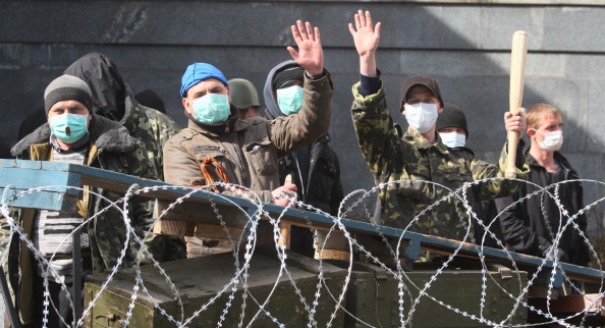Russia is systematically dividing up Ukraine. On April 6–7, pro-Russian protesters occupied key government buildings in the Eastern cities of Donetsk, Kharkiv, and Luhansk.
These are important cities, yet Ukrainian security forces have not defended them. It seems that Ukraine’s interim government has been completely unprepared to protect these urban centers despite weeks of propaganda and saber rattling by Russia. Kiev had adequate warnings.
Russian flags have been hoisted above the buildings that the protesters seized. Russian President Vladimir Putin is fast establishing solid facts on the ground. The ease with which he could seize and then annex Crimea on March 18 proved that the West was prepared to let the Ukrainian peninsula go.
Much now depends on how the West responds to Russia’s latest incursion. It is time for the EU and NATO to come clean about what their strategic interests are in Ukraine and how those interests influence their reactions to Russia’s land grab.
Let’s start with Germany.
Chancellor Angela Merkel must adopt a strong and unambiguous stand toward Russia, and that means much tougher sanctions. That is not easy for her. There is a consensus among the German public that Ukraine is difficult and perhaps not worth defending. The German public still sees Ukraine through the prism of Russia. It’s the same for Merkel’s conservatives, her Social Democratic coalition partners, and the rest of the country’s political elites.
But it is high time for Germany to abandon that prism, because it is not only the territorial integrity of Ukraine that is at stake. Such an approach amounts to legitimating Putinism—that perplexing combination of nineteenth-century nationalism, Orthodox Christianity, Putin’s KGB past, and a hankering after Russia’s lost empire.
The longer the German political elites view the Ukraine crisis through the prism of Russia, the more they will be susceptible to Putin’s ability to make Germans feel guilty.
As recently as March, Putin said that without Russian support, German reunification would not have been possible—implying that it was payback time for Germany. It was as if he were equating his annexation of Crimea with East Germany rejoining the West in 1990.
Germany’s finance minister, Wolfgang Schäuble, was having none of that. Speaking recently to school pupils, he remarked that Putin’s occupation of Crimea was similar to Hitler’s 1938 annexation of Sudetenland, then part of Czechoslovakia. It was an interesting comparison. Merkel rebuked him.
Because of Berlin’s close trade, economic, and political ties to Moscow, Germany’s stance on Ukraine and Russia influences the attitudes of the rest of Europe.
Other EU countries are divided over Ukraine. Poland and Sweden know full well why the EU should move quickly to provide economic support and financial assistance. But those measures are not enough, and they take time to kick in. Putin knows that. That is why NATO’s role is crucial.
There is no appetite in NATO for any military confrontation with Putin. Of course, Putin can criticize NATO for increasing its Eastern members’ defenses. But that is the role of the alliance—to defend its borders. The big question is what NATO can do to prevent Russia from taking over parts of Ukraine.
It is all very well that NATO is stepping up training programs and other cooperation with Ukraine’s defense forces. But the reality is that NATO is not going to defend Ukraine. Even if the alliance’s leaders know that Russia is now a threat, NATO will react only when Russia threatens one of its members. In short, NATO has drawn the line between those who belong to it and those who do not.
NATO deviated from that approach in 1999 during the Kosovo war, when Article 5, the alliance’s mutual-defense clause, was not at stake. It went into Afghanistan under the aegis of Article 5 again in 2003, not that the United States was particularly grateful at the time.
Both NATO and the EU are now witnessing Russia’s carving up of their big Eastern neighbor. The EU will be slow to impose tough sanctions. NATO will protect its borders, but that’s about all. Meanwhile, the post–Cold War dividing lines will be redrawn—indeed, they already are. European countries are not coming together to stop this because they don’t think it’s worth the effort. That is shameful. Europe, and later Russia, will pay a high price.






.jpg)